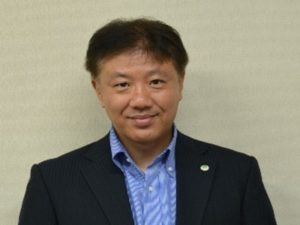The simple method enabled the next generation smart factory’s conceptual design in just half a day
| Issues before the PReP model’s introduction | – The discussion on what to achieve tended to digress often toward the means, not the end – Business processes became more complex |
| Results after the PReP model’s introduction | – The participants were able to concentrate on the discussion and complete the conceptual design of a smart factory system in half a day |

(From left) Mr. Takeshi Nonaka, Subaru Corporation, and Mr. Tomokazu Sato, JGC Holdings Corporation
The Engineering Study Group for the Next Generation Smart Factory (hereinafter referred to as the “Smart Factory Study Group”) was established in 2018 within the Engineering Advancement Association of Japan, with the participation of more than 20 companies, universities, and other organizations, and is conducting research on the smartification of factories. Specifically, there are three subcommittees: a research subcommittee to investigate the current situation in Japan and abroad, a human resources education subcommittee to develop human resources for smart factories, and a technology development subcommittee to put the concept of smart factories into practice. The PReP model was used in the technology development subcommittee.
We interviewed Mr. Takeshi Nonaka of Subaru Corporation, the leader of the technology development subcommittee, and Mr. Tomokazu Sato of JGC Holdings Corporation, a director of the Smart Factory Study Group, to discover how they used the PReP model to materialize the concept of a smart factory.
Recognized the PReP model’s potential for simplifying descriptions for drawing ideal business processes
What are the challenges in putting the concept of the smart factory into practice?
Mr. Sato: The concept of the “next generation smart factory” that the Smart Factory Study Group is aiming to achieve is a “central control system.” There was a concern that the participants had different images of what the central control system is and that they would not reach a consensus on the goal.
Mr. Nonaka: My own experience is that when we discuss what we think the system should be, we end up discussing the means. We would end up discussing, for example, “What is the best way to do it?” “Can we do this or not?” and so on, and it became very complicated when we tried to draw a business process flowchart.
What did you do to unify the image each participant has?
Mr. Nonaka: The members of the technology development subcommittee are from a wide range of backgrounds, including universities, IT companies, and manufacturing companies. This meant that we all had different images of what a smart factory would look like in our minds. So we decided to pick a specific type of business as an example and focus our discussions on it. We took up a made-to-order production-type business—like aircraft production, which I am very familiar with. The production process itself is common to all industries, yet in the case of aircrafts, it takes between one and three, four years from order to delivery. Moreover, the volume of products—that is to say, the number of aircrafts produced—is smaller than in many other industries, so it is not easy to build new facilities or production lines specifically for a product type. For this reason, even the production of a single part is outsourced according to types of treatment, such as machining, surface treatment, and painting. We are aware that the problem with the central control system is that “when multiple products are produced in a factory for low-volume, high-variety production, production processes conflict and end up in stagnation.” Therefore, we decided to set the scope of our study to include all products flowing through the factory production line, rather than limiting it to specific products.
How did you deal with the increasing complexity of business processes?
Mr. Nonaka: We had been struggling with this issue, indeed. When Hitachi, Ltd., which uses the PReP model, introduced us to this method, we expected that it would be a simple method to use. We discussed it in the Smart Factory Study Group and concluded that we should give it a try first.

Achieved the objective in the shortest possible time without any detours in the discussion and drew up the ideal image of the next generation smart factory in just half a day
How did you apply the PReP model in the Smart Factory Study Group?
Mr. Nonaka: First of all, my colleague and I explained the image of the current operational flow, and then Mr. Tanaka of K-plus Solutions, the developer of the PReP model, drew it in the PReP model to use it as material for the workshop. After that, we held an overnight intensive workshop to discuss the vision of the smart factory and, with Mr. Tanaka’s facilitation, created a PReP model flowchart based on the results of our discussions. About 15 of the members of the technology development subcommittee participated in the workshop: we discussed key themes together in a big group; then we were divided into three teams of five to six people to discuss the same issues and, finally, shared the results of breakout sessions again in a big group.
How was your experience of the PReP model workshop?
Mr. Nonaka: It usually takes a lot of time to draw business processes because you have many digressions and too much information. It’s a long way to go until you condense all of what was said and come up with a clear business process. This is what we were concerned about in this workshop. However, after the workshop, I found that the PReP model was efficient because we achieved the desired results in a very short time, in about half a day. We were able to get the results we wanted in a short time by going straight ahead without taking any detours.
Mr. Sato: To be honest, I was worried about how far we would get in deepening the discussion in this short period of time at the beginning. At the end of the workshop, I felt that the PReP model was a highly productive way of discussing specific details without losing the overall picture. Moreover, its notations were easy to understand, so I believe that the participants were able to discuss the content right away without having to worry about understanding them.


A method that can avoid the discussion of “how” and is compatible with system design
What is your assessment of the PReP model?
Mr. Nonaka: I think it’s a great tool for focusing the discussion on the “what (goal image),” not the “how (means).” To decide the “what” through discussions like we did in the workshop, discussions on the “how” should be avoided. Making a clear distinction between the two is important. However, once we start drawing a business flowchart, the discussion often tends to direct toward the “how” without deepening the discussion of the “what.” That’s where I always have trouble. But that wasn’t the case this time, and I felt that the PReP model is an effective approach for defining business goals.
Mr. Sato: I think it is effective for system requirements definition. When business analysts define system requirements, they need to create a business flowchart, a data model at a conceptual level, and a list of descriptions of functions and processes. Without this set of three documents, it is impossible to understand the scale of the system. The PReP model is a good way of drawing up the overall picture of the workflow and the operations. Since there is no standardized method for defining requirements, many people draw a business flowchart based on data and processes. For me, the product-based method, like the PReP model, seems natural because I have been taught since I started this job to think about system design in terms of basic outputs. But this is not always the case. I think the advantage of the PReP model is that it describes only the products, so it is compatible with system design and avoids unnecessary detours.

Clarifying the goal image of the next generation smart factory using the PReP model
What are the plans for future activities of the Smart Factory Study Group?
Mr. Nonaka: There are two major things we need to do. One is to brush up and finish the framework of the central control system, which we created using the PReP model at the workshop. The other is to contemplate the “next generation” factors further in the framework since it is what our Study Group is named for. We want to use the PReP model to clarify the goal image of a smart factory that incorporates “next generation” factors, like enabling autonomous decision-making or supporting line managers’ decision-making in factory rather than just drawing up the process flowchart.
Mr. Sato: There are many variations of central control systems, depending on each company’s production system and production format. Of course, the system requirements definition and implementation should be done by each company, but we want to make the common parts and concepts of the central control system a shared asset in the Smart Factory Study Group so that everyone can use it. At the moment, we are only working on the conceptual design, so we need to define the functions in order to reach a level where each company can define its own requirements. We would like to continue to use the PReP model to help us define these requirements.


Mr. Sato and Mr. Nonaka are working hard to envision and propose the next generation of smart factories. We look forward to continuing our support in materializing the central control system that the Smart Factory Study Group is envisioning!


